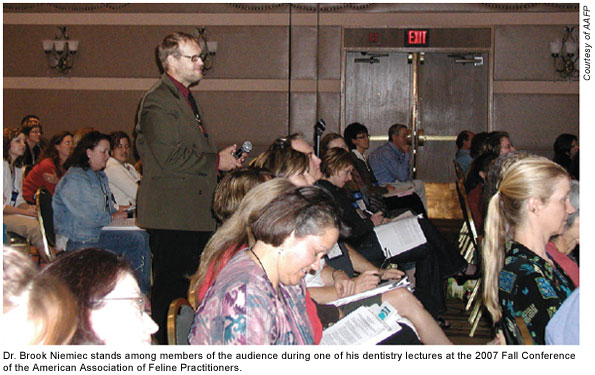Feline practitioners educate cat owners, themselves
The American Association of Feline Practitioners has stepped up efforts to get cat owners to visit veterinarians more regularly—whether or not the cats come willingly.
The association also continues to support high standards of practice, continuing education, and scientific investigation in the field of feline medicine.
At the Nov. 11-13, 2007, AAFP Fall Conference in Austin, Texas, attendees discussed relevant topics ranging from public outreach to feline dentistry.
AAFP initiatives
Dr. Valerie Creighton, incoming AAFP president, said the association has been tracking a disturbing trend: veterinary visits by cat owners have declined. One source that confirms the decline is the 2007 AVMA Pet Ownership and Demographics Sourcebook (see JAVMA, Jan. 1, 2008).
Partly to help reverse the trend, the AAFP has partnered with other organizations to offer public awareness campaigns and Web resources for cat owners.
"Our members are enormously skilled and talented in treating cats, but if no one takes the cats to them, then that skill is not fully utilized," said Rick Alampi, AAFP executive director.
The ongoing Healthy Cats for Life campaign, from the AAFP and Fort Dodge Animal Health, emphasizes twice-a-year veterinary visits and the fact that cats may have only subtle signs of illness. The program has a new Web site at healthycatsforlife.com.
The AAFP joined with Pfizer Animal Health and American Heartworm Society in 2007 to launch the KNOW Heartworms campaign, which teaches cat owners about the dangers of heartworms to cats. The program's Web site is at www.knowheartworms.org.
This year, the AAFP is launching a new Web site of its own at www.catvets.com, which will replace the association's old Web site at www.aafponline.org. The old site remains active during the transition period. Along with information for veterinarians and AAFP members, www.catvets.com will provide cat owners with useful and reliable information about feline health and wellness.
"Its orientation is to be a resource for everyone involved in the care and owning of cats," Alampi said. "It's part of our mission to elevate the standards of care, and owners are a huge part of that."

Alampi said the section of the Web site for cat owners is substantial and links to relevant organizations, such as the Cornell Feline Health Center. The section for veterinary professionals includes information about continuing education, practice guidelines, and position statements. The members' section includes association information along with links to the eMews electronic newsletter and AAFP publications.
Another big development for the AAFP is printing the Journal of Feline Medicine and Surgery once a month now instead of every other month. Dr. Creighton said every other issue will focus on articles applicable to practice.
"I think our members really love articles with a strong relevance to clinical practice that they can just immediately implement," she said.
Conference sessions
The AAFP conference also focused on topics with relevance to clinical practice—feline dentistry and diseases of the head and neck.
"These are topics which are relatively new to the mainstream and are, therefore, important to learn about," said Dr. Margie Scherk, outgoing AAFP president.
Many lectures discussed how to obtain and interpret dental radiographs, as well as radiographs of other parts of the head and neck, and how to provide analgesia during and after treatment.
Dr. Judy E. Rochette, who offers a traveling referral dental service in British Columbia, presented a critical review of home dental care products. She said a balanced home care regimen incorporates a dental-friendly diet, regular brushing, and judicious use of adjuncts. Veterinarians trying to assess a dental product should consider research, ingredients, safety, value, and cost. Veterinarians also can look for the seal of the Veterinary Oral Health Council.
Dr. Brook Niemiec of Southern California Veterinary Dental Specialties presented a potpourri of information about feline dentistry. One of his key points was that cats almost never stop eating because of oral pain. Drs. Niemiec and Rochette coordinated a roundtable session to conclude a full day of feline dentistry.
The subsequent two days of the conference focused on the upper respiratory tract. Sessions covered imaging of the head and neck, the frustrations of chronic sinusitis/rhinitis, otologic diseases, dermatologic conditions of the head, and diagnosis and treatment of cancer involving the mouth, head, and neck.
The AAFP conference attracted 422 attendees. Of that total, 164 were first-time attendees and 69 were veterinary technicians.
The association dedicated the conference to the late Dr. Jim Richards, who served as AAFP spokesman and director of the Cornell Feline Health Center. The AAFP past president died at age 58 after an accident last year.
"He was just a wonderful man whom we all admired," Dr. Creighton said.
The AAFP held a memorial reception during the conference. About 150 people attended, including Dr. Richards' widow and one of his sons.
Research grants
During the conference, the AAFP also announced recipients of research grants. The AAFP 2007 Annual Research Grant went to Dr. Dawn M. Boothe of Auburn University for her project "Evidence of effective drug delivery using transdermal gel delivery systems in cats."
The AAFP chose a recipient for a new grant from the American Veterinary Medical Foundation for research in vaccine-associated feline sarcoma. The recipient is Dr. Corey Saba of the University of the Georgia for her project "Phase II clinical evaluation of lomustine chemotherapy for feline vaccine-associated sarcomas."